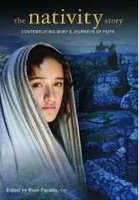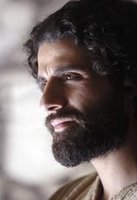
No sooner had Mel Gibson’s
The Passion of the Christ had its massive opening weekend, than it became inevitable that biblical epics would soon be back on our screens. Hollywood may not be religious as it once was, but it can still smell a buck. So, hot on the heels of the critical acclaim for the independently released
Mary (by Abel Ferrara), and Mark Dornford-May’s
Jezile (Son of Man) comes New Line’s
The Nativity Story.
The Nativity Story is actually the first bible film produced by a major Hollywood studio since Richard Gere donned a dodgy wig for
King David 20 years ago. Eager to avoid the box office failure of that film, New Line have been pretty canny in their choice. In Mike Rich, they have a writer whose mainstream Christianity will be popular with US evangelicals, and in Catherine Hardwicke they have a director with such critical acclaim for her previous work that even the most ardent Christian-sceptic film critics have been prepared to suspend judgement. The film's one marketing glitch is that it is far less controversial than
The Passion potentially losing hours of free publicity as a result. A few uninspired journalists have tried to whip up a bit of controversy over lead actress Keisha Castle-Hughes' unexpected pregnancy, but otherwise there is not much to report.
The story of the nativity is one that it is so well known, and so central to western culture, that it is hard to believe that so few films have been made about it. Just one theatrically released, English language, feature film has been made about Jesus' birth since 1914. True, a few films have used it as a prologue to the adult life of Jesus, but its comparative absence amongst the super-abundance of Christmas films is staggering.
Yet despite its uniqueness, it can't quite decide what kind of bible film it wants to be. The title suggests a mythic retelling, perhaps aimed at the family, yet the early scenes have a gritty, realistic feel to them. Later on though the film morphs into a sort of road movie as Mary and Joseph get acquainted and start to appreciate one another. Then it changes gear yet again once the holy couple reaches Bethlehem. The last remaining vestiges of realism are swiftly ditched and out comes a touch of the Christmas magic. The light from the star shines through a hole in the roof and makes the coldest and dampest of caves seem warm and lovely. Finally, the film ends with the new family fleeing from Herod, ending the film as if it's the close of part 1 of an action trilogy.

It's not that there is anything particularly wrong with any of these different styles; it just leads to a very uneven film. It would have been far better to choose one style and stick with it throughout. For me, it's the gritty realistic style that the movie opens with that serves the film best. Catherine Hardwicke has made a name for herself both as a production designer and as a director of realistic films about teenagers from poor families. Here both talents blend together marvellously in the opening scenes. Nazareth is recreated more believably here than in any other Jesus film to date, save possibly Pier Paolo Pasolini's
Il Vangelo Secondo Matteo. Arguably late-twentieth-century scholarship's greatest contribution to our understanding of Jesus is the additional insights it has given us into the peasant world that Jesus was born into. Writers, such as John Dominic Crossan, have emphasised how ordinary people in first century Galilee existed barely a whisker above poverty and destitution. The first half-hour of this movie captures this brilliantly. As the camera weaves between the crumbling dwellings it takes in the dirt of peasant life. It's a world where people sell on their small surpluses to neighbours, and are nearly always working at one small task or another, children as well as adults. Where pre-mature tax collection or failed harvests mean catastrophe. The fields are not full of post-agricultural revolution golden grain, but straggling plants seeking to work their way out of the mud. It's easy to see that this world would incubate a revolutionist dream, a fact underlined by the failed, crucified zealots that are shockingly encountered, not as something extraordinary, but just as part of every day life.
Yet the film not only emphasises the hopes for a military messiah, but also indicates that this is not the way God works. Twice 1 Kings 19:11 is recited as people recall how Elijah hears God not in the wind, fire and earthquake but in the still small voice. Jesus would come from small and humble beginnings not Herod's grand and imposing palace. Herod's fear of a king not of his line is nicely portrayed by Ciarin Hinds who has managed to play both Herod and Caesar within the space of a year or two. He is one of four fathers in the film, all of which are performed very well. Stanley Townsend as Zechariah creates one of the film's most touching scenes despite being mute for the majority of his screen time. As Mary's father, Shaun Toub, encapsulates the toll his way of life takes. There's a heaviness to his every move, and his drawn face speaks of a life that has felt long and hard.

Toub is one of a number of non-white members of the cast, another factor which adds to the authenticity of the film. Keisha Castle Hughes is Maori, Shoreh Agadashoo, who plays Elizabeth is Iranian, Hiam Abbas (Mary's mother Anna) was actually born in Nazareth, whilst Oscar Isaac (Joseph) has his roots in Guatemala. As the fourth father, Isaac's performance is probably the best of the lot. Whilst the screenplay harmonises the emphasis on Joseph from Matthew's gospel, with the emphasis on Mary from Luke, the film is marginally more concerned with her story than his. Yet Isaac's performance makes Joseph the most interesting and compelling character. This becomes his story and his journey. It's often been noted how difficult it is to portray good characters in an interesting manner, and Isaac has only the single personality trait, "righteous", to go by. Yet he manages to not only embody this characteristic at the start of the film, but also to improve upon it as the picture progresses. Whilst his evident desire for the teenage Mary is initially uncomfortable for us, there is never any suggestion that it is untoward. One of the best scenes in the film is when he has a dream about stoning Mary only to be prevented from doing so by an angel.
But the writing often fails to live up to this scene's promise. All too often the dialogue seems forced, awkward or clunky. The use of middle eastern accents works in many ways but only serves to highlight the weaknesses in the script. Elsewhere it labours to present unnecessary, overly earnest factual background information, taking the viewer right out of the narrative flow with such passages far more suited to an educational movie. Would a star gazing magi really talk to his colleague about the planet that "the Romans call Jupiter" as if it was the first time they had discussed it? Similarly, Joseph's description of a shepherd's lifestyle is all very interesting, but he may as well have directly addressed the camera as painfully try to pass it off as the kind of thing one would actually say to the daughter of a goat owner just before she gives birth?
It's also highly debatable whether substituting the three stooges for the magi really works. It gives the film more of that Twenty First century Christmas schmaltz and undoes so much of the good work in making the film realistic. There are moments of genuine humour, but it detracts from the flow of the film, rather than enhances it.

All of which is a shame, because overall the film is more good than bad, just. Sadly the film betrays the fact that it was a rush-job. Keen to cash in on
The Passion of the Christ, New Line forced this project through within a year of writer Mike Rich sitting down to start the screenplay. It's a shame that they didn't give the film another year in order to re-work its bad parts, build on the good and create a film truly worthy of the subject matter.
Labels: Nativity - Mary Joseph, Nativity Story (The)
 It's had been 3 years since I last saw The Nativity Story, indeed, after the hours spent discussing the build up to the film I had only seen it once in its entirety. So this year I decided I really should watch it again in the run up to Christmas.
It's had been 3 years since I last saw The Nativity Story, indeed, after the hours spent discussing the build up to the film I had only seen it once in its entirety. So this year I decided I really should watch it again in the run up to Christmas. 













































